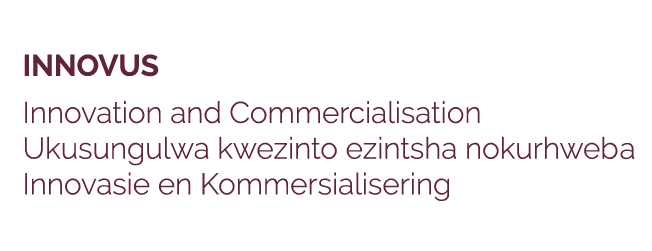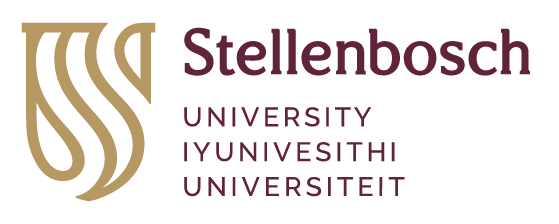Globally, 2016 was a bit like a Michael Bay movie (without Megan Fox or lens flares): packed with far more action than we're used to - with #Fees, Trumps, Brexits, Olympics, Zika, hurricanes and earthquakes, new Potters, Tesla's Autopilot… It was no different here at Innovus – although our action has been far more positive! Here are just a few of the highlights of last year.

After months of meetings, reviews, panels, opinions and input, the Trademark Policy, which governs where and when Stellenbosch University's name and identity can be used, was finalised. Maties Football, which has been under our curation for the last 4 years, is finally ready to gear up and step out on its own. Together with our partner, Forwardzone, and with world class facilities and training, we are now a much more attractive football 'destination' and are expecting results this year that match those of our academic endeavours. Our Short Courses Division, under the eagle-eye of Carol Kat, has maintained over 500 individual courses being run yearly and, with the (rather sexy) new website going live, has become substantially easier to navigate – and the 15000-odd registrations are an accurate reflection of the improvements made. To better cater for Stellenbosch University's medical students, we opened our first satellite office on the Tygerberg campus. We now have a dedicated staff-member on-site every Thursday – pop in for a coffee!
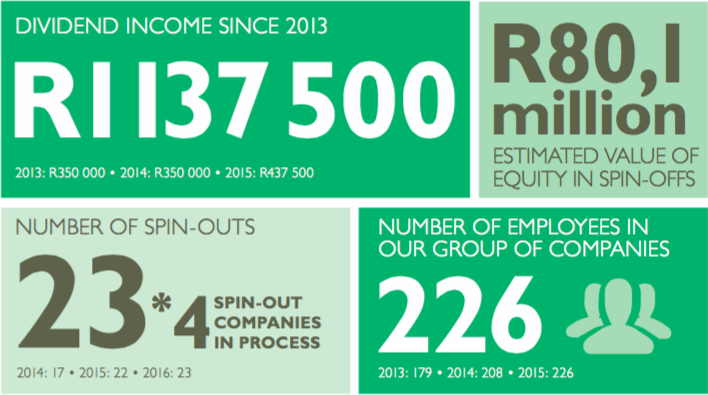
On a personal note, we were very lucky to have grown our family with our new technology transfer officer, Nolene Singh, and accounting wunderkind, Baryl Strauss, while a teary farewell was bid to both Johnathan Smit, who left to head up Deloitte's Greenhouse, and Venessa Williams, who is now focusing on her young child.
We'd collectively busier than proverbial bees last year. Researchers at our University developed a piezoelectric nanosensor that can be used to detect pathogens – in a body of water or a body of a person – far more accurately and far less expensively than existing solutions. All it needs now is a cool name.
SharkSafe (which makes our oceans safer from sharks and for sharks) received its second round of Funding from TIA, and recently completed its second year of testing, where it proved 100% successful in excluding white sharks from the area in which it was installed. Sporatec, a device that samples and detects fungal and bacterial air (in anywhere from hospitals to homes) is on the verge of becomming a commercial company, so the service can be made available across the country.
We're also making huge progress with the licensing of both the wheat and grain varietals, which are both in the process of being licensed.
In September last year we put out a call for 'incremental innovations' that are less traditional, but just as valuable. The Faster Kettle is looking promising, while the Childproof Seat-belt Clip is kicking into its 'use-test' phase. And don't forget Dog's Best Friend, a motion-sensor water-feeder (which our own William Cloete is helping to develop), is also about to enter its own 'use-case' development stage.
Our most delicious innovation, S'Cool Beans, placed second in the 2016 IUFoST's (International Union of Food Science and Technology) Food Scientists Fighting Hunger competition. For those who haven't tried it yet, S'Cool Beans is a nutritious, bean-based spread, that doesn't taste like a nutritious, bean-based spread – and you should be able to find it on the shelves of certain major retailers very shortly. The 2016 Department of Food Science New Product Development Competition has also yielded some tasty new treats, which you can read about a little later in this newsletter.
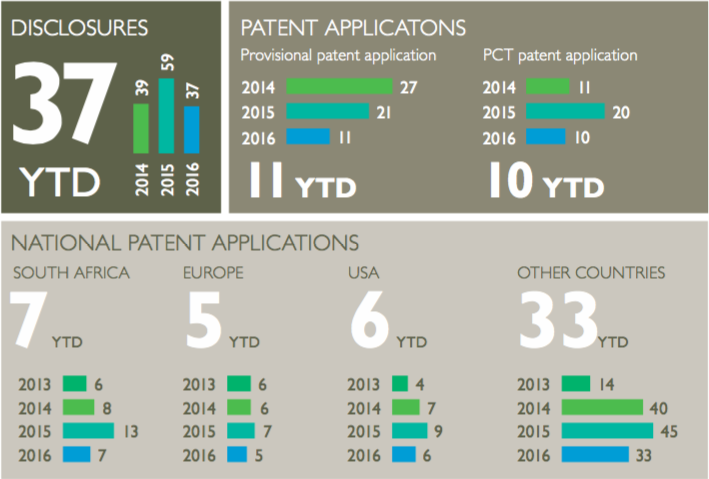
2016 was a remarkable year for fledgeling Innovus companies. CubeSpace took off (literally), as their ZA-AeroSat satellite made its way to the International Space Station, where it will gather research information on the (mostly unexplored) lower thermosphere, The business itself will be incorporated this year. Synsurf, makers of one of the only two synthetic lung surfactants on the planet, has further distanced itself from competition by adding anti-cancer and anti-inflammatory properties to its patent application, and it can also now be used for the transmission of medication to patient through the surfactant itself (a far more effective transmission mechanic in many cases). BridgIoT launched their new GeasyTM Mark 4 device, which is substantially smaller and more cost effective, and then tested and installed over 180 units, all running on their cloud platform (another 120 should be installed by next month). Custos Media Technologies, one of our spin-out companies and a tenant in the LaunchLab raised a fortune in funding (R6m of which came from TIA)… They are about to launch into the eBook industry, as well as preparing to enter into the Grindstone Start-Up Accelerator Programme, which is currently open for submission.
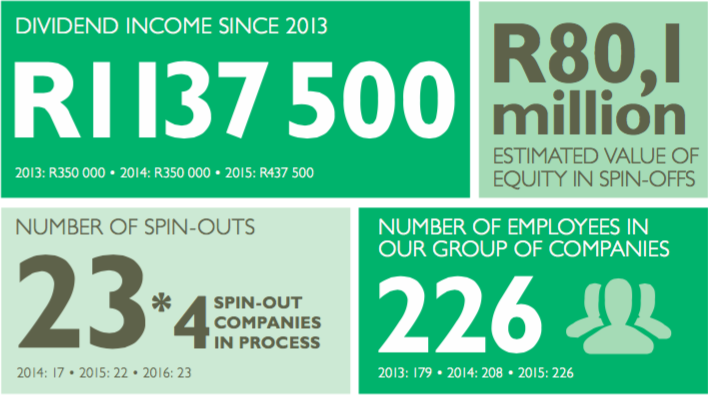
The Nedbank Stellenbosch University LaunchLab did (and is still doing) a remarkable job of attracting corporate interest in their tenants (some of whom we mentioned in the previous section), but also in The LaunchLab itself. Santam, MultiChoice, Nedbank and Attacq have all hitched their wagons to our rides as sponsors.
We're proud to state that our Technology Transfer Offices pulled the weight of thousands last year, and are currently running one of the most successful portfolios of all the TIA Seed Fund projects. We also managed to acquire funding from the TIA Seed Fund for 9 new projects, like X-Ray Phantom, Quad-mode antenna and TB Biomarker, and establish 5 completely new companies. That's over R3mil put to very good use…
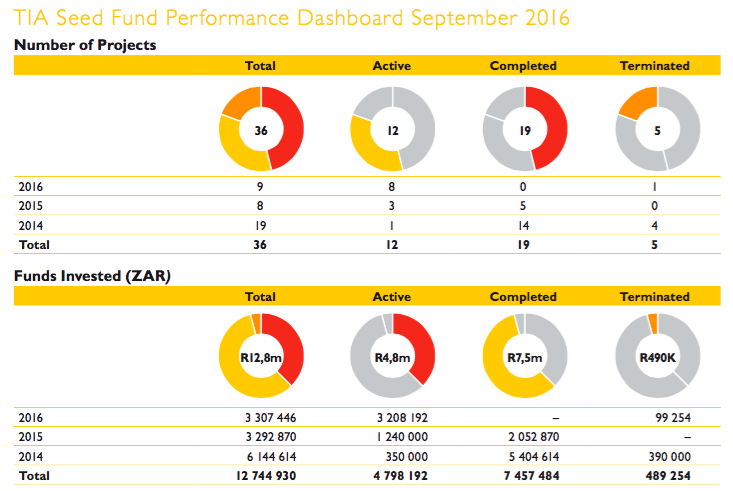
A few months ago we set out with a few other universities to create a University Technology Fund that would allow universities across South Africa to provide support and funding for their technology projects, making a bigger difference than they could in isolation. We're ecstatic to tell you that, while it's still early days, the amount of interest we've received from high-level investors is really promising, and we're in the process of finalising the documentation. More about coming soon!
Overall, 2016 was a year we're very proud of, and we could not have done it without the remarkably dedicated team at Innovus, or the brilliance and persistence of the minds at Stellenbosch University. Our researchers never cease to amaze us with the wonderful inventions they make and it is a privilege for us to work with you on bringing these projects to the market.
But we don't plan on taking is easy in this year. Keep an eye out for some interesting developments over the next few months.
Until then we wish all our staff, friends, investors and associates a very happy festive season.
When it comes to the art of the long and healthy life, many of us would agree that our hearts are the most important organ. And while many of us have never needed to visit a cardiologist (and hopefully the majority never will), if that day does come, we're probably within a few kilometres of a specialist who can quickly listen, diagnose and prescribe a solution.
But, what about the almost 20-million people living outside of major urban centres? For whom distance (and a lack of transport to conquer it) is as big a deal as the lack of specialists available to listen, diagnose and prescribe? In fact, our country as a whole is remarkably light on specialist skills; while the Boston Children's Hospital in the States has more than 75 paediatric cardiologists, we have exactly 24 in the entire country, which makes finding the right specialist at the right time close to impossible (not to mention expensive) for our rural communities. This is especially worrying when you take into account that 1 in a hundred babies are born with a congenital heart defect.
This may not be our biggest health issue, with HIV/AIDS remaining at the top of everyone's list, but if you consider the fact that more than 200 people die every day from heart-related illness, it's still a major one. And while nurses, who visit rural areas, acting as medical proxies for different areas of medicine, can advise and assist in many different fields, armed as they are with first-aid kits, HIV and TB testing devices, and general health skills, they do not have expertise to detect heart issues. And one thing cardiologists are not is 'portable'…
Until now
SensiCardiac, a new device developed by a team of engineers at Stellenbosch University, uses the sound of a heartbeat (irregular or otherwise), captured digitally and processed through intelligent algorithms to accurately identify and diagnose heart problems – a portable, digital cardiologist. By combining a digital stethoscope with a bespoke database of over 2 000 different heart sounds (more than 30 000 individual beats - the largest database in the world), they've designed a system that speeds up and increases the accuracy of cardiac diagnoses – structural heart defects, indicated by pathological and physiological murmurs, and their position (systolic or diastolic) and even their grading, can be identified by almost anyone, anywhere. Think of it as Shazam for hearts.
On top of that, it also visualises and records the sounds, which can then be stored (for subsequent meetings) or be shared with other specialists. Because it has an accuracy of 90%, it reduces unnecessary (and costly) referrals, easing the burden on wallets and our hospitals, by as much as 60%.
It's a decision support system for our primary care workers – and a digital second opinion for cardiac specialists.
The idea behind SensiCardiac was originally the master's thesis of co-founder, Jacque de Vos, back in 2003. Together with co-founder Thys Cronje, he approached Innovus during the research stage to commercialise the IP they had so diligently developed. They also knew they had the beginnings of something amazing, and wanted to eventually create a business from it. In Innovus they found the knowledge partner they needed, with the right contacts for commercialisation and funding. And what a partnership it has been thus far.
Part of the Innovus mandate is to create self-sustaining spin-out companies from the technologies and IP developed in the University. In 2007 Diacoustic Medical Devices (Pty) Ltd was created, which has gone on to further develop the technology behind SensiCardiac, and attract shareholders in the IDC, Stellenbosch University and GeoMed. It has even been certified by the FDA.
"They are the leading TTO in South Africa," says Thys, "and it's been a pleasure working with them."
Believe it or not, the SensiCardiac technology is gaining a fair amount of traction in America, where there is significant competition with established companies. The fact that it's succeeding at that '1st world' level speaks volumes about exactly what Thys, Jacque and Business Development Manager, Michael Maas (M.Eng), have built. The next steps are to make sure that South Africa's citizens and healthcare workers have access to SensiCardiac technology in clinics across the country.
Diacoustic Medical Devices and their brainchild, SensiCardiac, are excellent examples of the quality of research taking place in Stellenbosch University's medical department, how intellectual endeavours can be emotionally and financially rewarding, too, as well as exactly how important the right partnerships can be – for each other, and for our country.
In the gloomy shadow of our countries controversies, unrest and political shenanigans it can be hard to see exactly how much our government actually does for us. But, believe it or not, it's a fair amount.
Among revolutionary humanitarian initiatives already in place (that you're probably not aware of) like Tshwane's free Wifi program and Namola (think Uber for police) our government is also helping to fund our nation's researchers, professors and intelligentsia in their own efforts to make tomorrow a little brighter than today.
Every year our government funnels millions of Rands into different universities and science councils, funding ideas and technologies that will assist in the constant betterment of our country.
In order to make sure that the intellectual property developed during the research is actually put to use, and that South Africa can extract the maximum benefit from our tax Rands, the Intellectual Property Rights from Publicly Financed Research and Development Act (or IPR Act) was created. The entire purpose of this Act is to make sure that the public funds invested in the ideas of our best and brightest come back to benefit our society, rather than being shipped offshore for profit, and then relicensed back to us, or left on the shelf to gather dust. For South Africans, by South Africa, so to speak.
But who ensures that this all happens? The supervisors of the Act are NIPMO (National Intellectual Property Management Organisation). As an office of the Department of Science and Technology, it is NIPMO's duty to ensure that new knowledge created from publicly financed research are identified and protected , thus supporting, and enabling, a more ingenious society. (An interesting point to note is that NIPMO also ensures that the IP rights of our indigenous peoples, who are often taken advantage of and marginalised by commercial companies, are protected.)
With the IPR Act, NIPMO really does have our inventive backs when it comes to research and development. To quote Jetane Weyers, NIPMO's Director of Regulatory and Compliance, "He who creates, owns." Any invention that solves a problem, in a non-obvious way, and has an element of novelty, be it in basic or applied research, or in experimental development, it now sacrosanct. And it makes life substantially easier for our Technology Transfer Offices, too. As the body to whom the TTOs identify and report their intellectual property, as well as the repository and database for all publicly funded IP, they remove a chunk of the exhaustive admin from entities like Innovus, allowing them to focus on the promotion and commercialisation of the technologies being developed. They also make sure that this IP is protected, utilised and commercialised, and at the same time they feed universities with the funding to employ new staff members to help them comply with the Act.
How does this impact our lives? To prevent the destruction of any chance of a potential patent, all inventions that grew in the soil of public funds must be disclosed to your TTO, before they are disclosed publically. (You can download Innovus' disclosure form here.) But, as I think I've made abundantly clear above, this really is in the best interest of everyone. Once the invention is disclosed, it can be protected, which means you, and your future aspirations are, too.
With the IPR Act, those who put in the effort will reap the benefits – both the inventor, the institution they represent and our country
If you are a student at Stellenbosch University with a big idea and the skills to make it a reality, then getting to Innovus for their assistance is fairly easy – they are just around the corner. But what if you're one of the many medical students, studying at the Tygerberg campus? It's a bit of a drive when you're busy trying to bash out theses, projects and generally get your work done.
With the amount of innovations coming out of the medical faculty you would… oh, you'd like a list? Fair enough – these innovators deserve all the time we can give them. Well, there are the TB-detecting biomarkers that are being developed, and the nanosensors which can detect both the purity of water and any diseases present in it in minutes. Then there's Sporatec, who are building air-testing solutions for everyone from shopping malls to hospitals, detecting life-threatening airborne allergens (as well as some that are merely annoying) before they become a problem. Opthalmic medicaments, Synsurf's synthetic lung surfactants, heart valves – the list, really, really does go on.
To better serve the medical innovators, and make sure that inventions in this space are constantly encouraged, Innovus decided to open line-of-sight and open up shop on their campus in Tygerberg. As of September last year, you can now find a smiling, intelligent TTO on the 5th floor of the Educational Building, who can discuss any ideas or issues an innovator may have. The office will be manned by rotating staff (both equally passionate and dedicated – I can vouch for each) every Thursday. William Cloete, one of the two smiling faces believes that the close proximity to 'where the action is' will make it easier for medical students and faculty to get their ideas protected, supported, propagated and commercialised – which, after all, is exactly why Innovus exist in the first place.
As you may be aware from last year's newsletters, the Department of Food Sciences at Stellenbosch University hosts an annual food science's competition, where our best, brightest bakers are tasked with solving a particular problem.
If you have read the previous articles, you'll be aware of the incredibly high standard of both ingenuity and execution we've come to expect from these final year students. 2015's 'Stealth Health' competition saw the world being served the wonder of S'cool Beans, the sneakily wholesome low-sugar, low-sodium spread that went on to place second at the International Union of Food Science and Technology global competition in Ireland.
And 2016 was no different.
2016's theme of Nutritious Treats for Kids with Food Sensitivities (every word in there is a criterion for entrance) was as relevant as ever, considering the increasing number of food sensitivities, especially in our younger citizens. But the challenge was bigger than just the creation of healthy snacks – each product was also required to be sound scientifically, marketable and have at least a 7-day shelf life. The most recent competition saw 6 entrants vying for top-spot with their equally brilliant peers with some of the most remarkable innovations yet.
Gell-O-Pop is a fruit and vegetable-based jelly lollipop, with an accompanying coconut popping candy sherbet. Pudding Clouds are cookie cups, filled to the brim with a vegetable (and yet still deliciously desserty) filling, and crowned with marshmallow. Holey Moley (indeed!) is a doughnut made from pumpkin (rather than flour and sugar), and glazed with coconut milk, vanilla essence and a honey/cinnamon crumble. (Innovus' William Cloete has been heard describing Holey Moley as "The best darn doughnut I've ever had!"). Mmnandi is a fruit flavoured mousse, but crafted from potato milk (believe it or not), while No-moo decided to create a strawberry and caramel frozen macadamia nut milk and root vegetable dessert.
Delicious, nutritious kids' food, with packed with healthy, natural ingredients and happily light on allergens and animal products.
The most impressive of the lot, and the winner, was the rather delectable, Jungle Bungle. The team, who initially set out to develop a vegetable-based cultured soya product as a yoghurt replacement (there are only two available locally at the moment, and neither are vegetable based), ended up also creating healthy, edible cutlery – both of which had their flavour profiles paired with each other. Yes, that's right: you eat your healthy, allergen-free, beetroot-and-cocoa 'yoghurt', and then you eat the seed-and-honey biscuit spoon!
The Jungle Bungle team cleaned up in all three of the judging categories, being voted Most Commercialisable, Most Innovative and the Crowd Favourite.
With a R7500 cash prize in their pocket, the Jungle Bungle inventors will also have Innovus' support, and network of connections, as they set out to promulgate and commercialise their tasty new innovations, and get them to market. We're expecting that, like the judges on the panel, investors and FMCG companies are just dying to dig in.
A trio of friends at Stellenbosch University identified a challenge that many students face; during term time they had space in their hostels and residences to have some of their belongings and necessities. However, as soon as the University breaks for holidays, it was impractical to travel all the way home with these belongings.
Michael-John Dippenaar, Michael Louis and Henri Bam all experienced the frustration of this logistical nightmare during their studies, and recount the stress of trying to find somewhere that is safe and cost-effective to store their belongings over the holiday period. Initially, Michael-John wanted to buy a warehouse, and rent out storage space, but when he really looked at the numbers, it was impossible to offer storage to students at prices that suited their budget. This model of paid storage is also restrictive in terms of accessibility and convenience. The three co-founders, or as they like to be known, the Scurry, came up with a solution to this problem, and Sxuirrel came into existence to operate as storage platform that is based on a similar principle as Airbnb.
There are those who have space who would be willing to store things for a fee, and there are those who are willing to pay a moderate fee to have their items stored. Everybody wins. This service is a great example of the disruptive innovations that have taken the world by storm. When the Sxuirrel team presented their vision for addressing this natural demand they were one of the winners at the LaunchLab Ideas 2016 competition and subsequently earned a spot as an incubator startup company in the The Nedbank Stellenbosch University LaunchLab space. The Scurry say that the incubator programme has been invaluable for their companies development, the network is a huge asset, the positive energy and support has carried them through challenges and they could lean on other startups to help with problem-solving as essentially they are all in the same boat.
They are looking forward to entering the Knowledge Acceleration Programme (KAP) and the Countdown Programme which assists startups in setting up the company, advising them on their equity agreements and introduces them to investors. These programmes also include business management and growth theory to help the startups get on to their feet. Of course there are challenges for any startup company, the Scurry said that keeping your momentum for your startup is vital to realising your goals, but this can be incredibly difficult as all three of them are also full-time students. -Studies and exams take preference, but time management and learning how to balance your interest became sink or swim skills for the Scurry. Further, they admit there are many moments where you have a crisis of confidence as a team, and worry about whether your service or method of delivery is novel enough to make its way into the market. Sxuirrel says now that they are days away from launching and looking back over their development, they feel that the LaunchLab definitely aided them in learning those skills. Now their focus is to earn traction in the local market starting with targeting students and then scaling up to the whole of the South African market. They have exciting plans to expand their services to a whole range of SPACE solutions including storage, parking,office and work space.
Who knows, next year this time Sxuirrel may be a household name, like Uber and Airbnb. Innovus, the university-industry interaction and innovation company of Stellenbosch University, wish them all the very best of luck in their endeavour!
The world of pulmonary surfactants is more established than you may think, and it's also more complicated. The short explanation (for those who, like the author, don't have a masters in pharmacology) is 'a mixture of proteins and lipids that are secreted by cells in the lungs to reduce surface tension at the air/liquid interface within those lungs, stopping the alveoli from collapsing during exhalation and facilitating gaseous exchange (oxygen in, CO2 out).' A synthetic surfactant is needed when the lungs aren't able to produce it themselves (due to respiratory diseases, emphysema, or premature birth) and, because we all really, really need to breathe, they are listed on the WHO's Model list of essential medicines.
So you can understand why Synsurf, the (relatively) new synthetic surfactant on the block has taken so long to develop to the point it is now. It was started over 20 years ago by Prof Johan Smith, from the Department of Paediatrics and Child Care, for his PhD thesis. He wanted to create something with a much higher efficacy (and much less variation) than the often 'problematic' alternatives, many of which are expensive (quick fact: phospholipids, an essential ingredient, are, gram-for-gram, more expensive than gold) and animal derived, thus adding the potential risk of animal disease transmission to the patient you're trying to save. But it wasn't easy. After many years of different partners, setbacks, market-issues (like a similar product disappearing inexplicably from the world), Prof Smith pushed on. And thank goodness he did. The result of his (and others') hard work is a completely synthetic, animal-free surfactant that behaves exactly like naturally occurring surfactant proteins, is supplemented with spreading agents and polypeptides and performs a better job of oxygenation (the entire point of the exercise) than the current options.
On top of that, Synsurf is also a remarkably good transmission vehicle for medication (like HIV or TB meds), which is something the others can't do and often the best way to get the right medicine into the body. This was an unforeseen benefit or, 'happy accident', but so was penicillin and Viagra.
Because it consists of simple, commercially available ingredients, it's both commercially viable and commercially scalable.
Innovus have been a critical component of the journey thus far. Before engaging with the team, the inventors had an understandable lack of knowledge when it came to IP protection and investor networks. They also saw the commercial applications, but had no idea how to ramp it up to that level. As Prof Smit puts in, "[Innovus] Took our fears away", and he has since taken new innovations of his to the team.
Synsurf meets all of Innovus' criteria of a world-changing innovation: it is novel, necessary and has major commercial potential, and the world is taking notice: an investor has come on board and phase 2 of testing with a larger company is about to begin. In a world of less-than-perfect solutions and overpriced, life-saving pharmaceuticals, Synsurf is like a breath of fresh air.
Innovus, Stellenbosch University
|
15 De Beer Street
Stellenbosch
7600
South Africa
|
PO Box 3135
Matieland
7602
South Africa
|
|
t +27 (0) 21 808 3826
e info@innovus.co.za
e forms@sun.ac.za |
